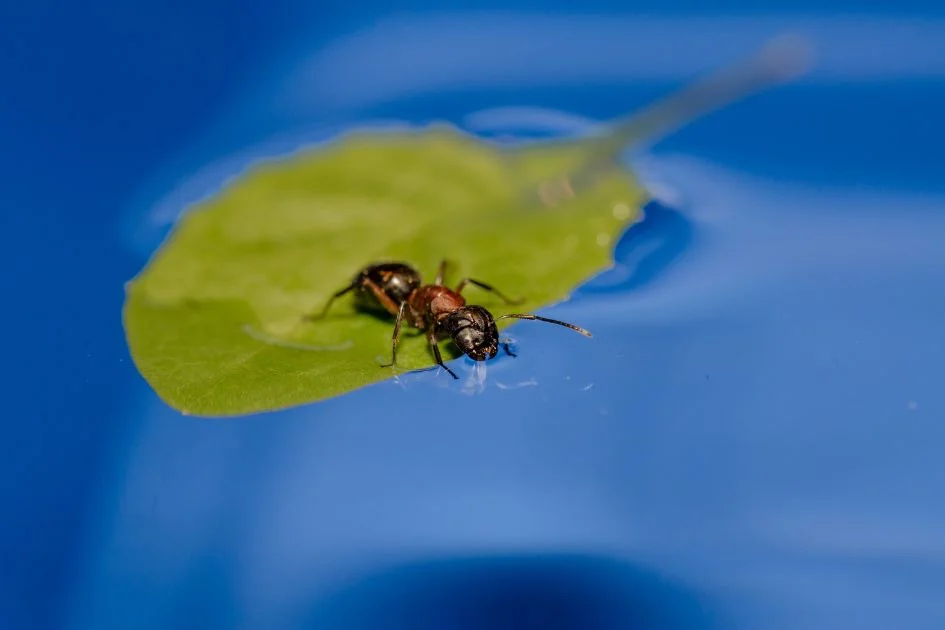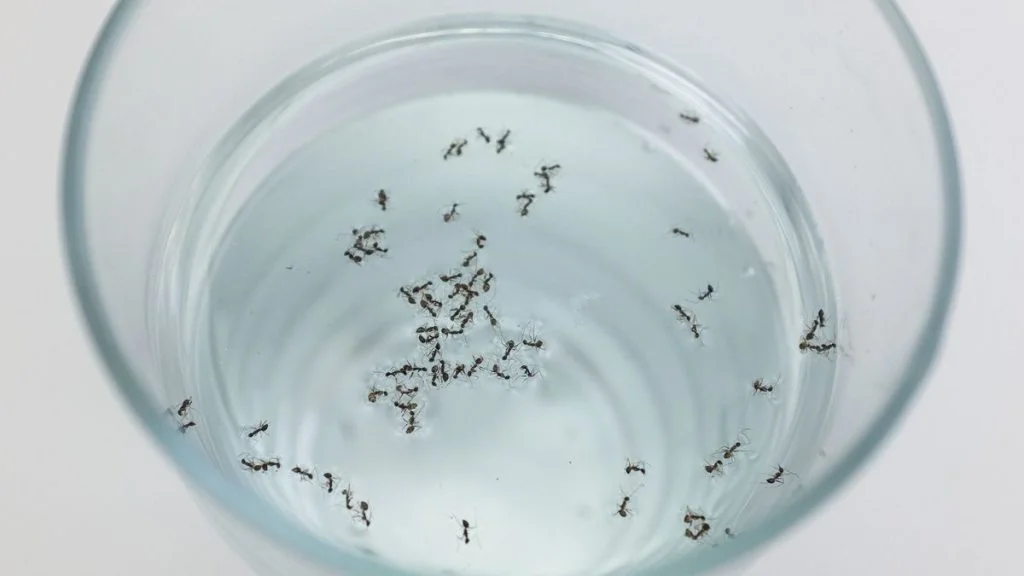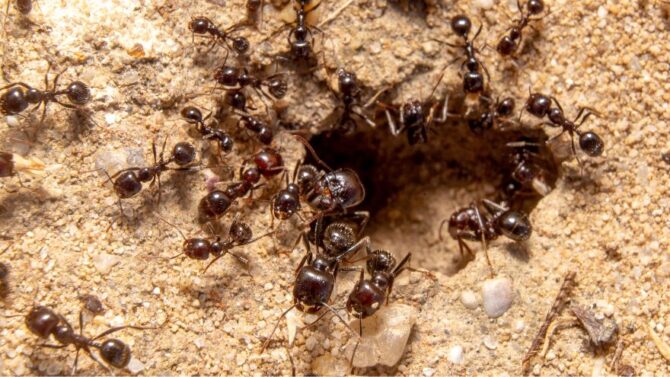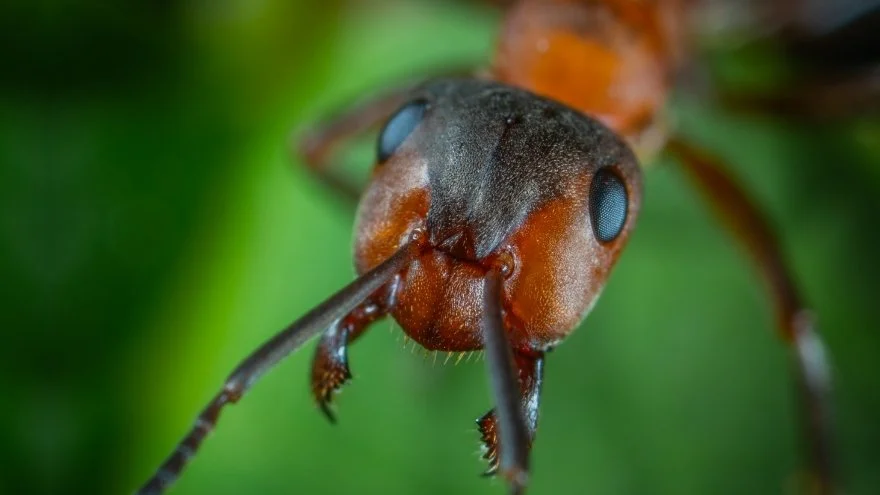Ants are one of the tiniest animals on this planet and are known to be great survivors.
Although they don’t have lungs to store deep breaths or long limbs to wade in the water, can ants swim in water?
Ants can swim in water; however, not all species can. Additionally, some species like fire ants escape floods by linking their bodies together to make a giant raft.
Studies show that this method prevents the water from reaching the other ants above the rafting base because their bodies are tightly knit.
Most times, they can go in this formation for weeks. Also, they can recover, even after being underwater for up to 24 hours, and some can go up to 14 days.
Read on to learn more about the different species of swimming ants.
Can Ants Swim in Water?

If you’ve ever had ants in your backyard or around your house, you’ve probably also tried to drown them by flooding their nests with water, which didn’t work.
The reason is that ants don’t have lungs, so you can’t suffocate them with water. Ants breathe through their spiracles, and they can shut them for days while they swim to safety.
Ants can swim in water; however, some species are exceptionally good at it.
Top 5 Species of Swimming Ants
The trap-jaw, gigantiops, diving, black carpenter, and hairy panther ants are among ant species that can swim and wade through water whenever the need arises:
Trap-jaw Ants
- Scientific name: Odontomachus bauri
- Habitat: Arboreal, Terrestrial, Marine
- Diet: Omnivore
- Range: Forests in South America
The trap-jaw ants are the most popular species that swim. When they find themselves in water, they use one of their hind legs to stay afloat, while one of their front and middle legs moves their body forward.
These ants can swim over large bodies of water swiftly without getting tired. Naturally, they live on trees, land, and water.
Gigantiops
- Scientific name: Gigantiops destructor
- Habitat: Arboreal
- Diet: Omnivore
- Range: South America
The gigantiops can swim 16 cm per second when plunged into the water. They swim just like the trap-jaw ants, except that they are faster.
They use their hind legs to provide stability and prevent them from drowning, while their fore and mid legs propel their bodies forward.
Diving Ants
- Scientific name: Colobopsis schmitzi
- Habitat: Arboreal, Marine
- Diet: Omnivore
- Range: Inside Pitcher Plants in Borneo Island, Asia.
These species are the most daring of the five listed in this article. They live inside the famous carnivorous pitcher plants and steal insects from inside them.
The diving ants are natural swimmers who do well aquatically. Their relationship with pitcher plants is symbiotic and proves that two organisms can indeed be beneficial to each other.
Black Carpenter Ants
- Scientific name: Camponotus pennsylvanicus
- Habitat: Arboreal
- Diet: Omnivore
- Range: United States, Canada
The black carpenter ants are a species of ants that feel at home in the water. It quickly adapts when it finds itself in water, taking a boat’s position.
Black carpenter ants use their hind legs as rudders to steer their body in whatever direction they plan to go while using their forelegs to paddle their weight forward and their midlegs to row.
These ants are especially smart and find it very easy to adapt to dangerous situations.
Hairy Panther Ants
- Scientific name: Pachycondyla villosa
- Habitat: Terrestrial
- Diet: Omnivore
- Range: North America
The hairy panther ant is a species of ants that live in North America. These insects make swimming look simple, especially when they’re in danger of drowning.
In such situations, they move their legs swiftly through the water so they can move through. They also try to climb onto foreign objects in the water so they can get to the seashore quickly.
Are there Underwater Ants?
Some ants can survive underwater for long periods, but no ant permanently lives underwater like fishes do.
Some ants live in swampy areas and are more exposed to water. One of those ants is the Polyrhachis Sokolova. These ants are known for their fantastic swimming skills and their unconventional diet.
They do not feed on nectar and sugar like other ants but tend to be attracted to seafood like clams and crabs. Underwater ants also eat larvae, which they find in the bodies of the dead crabs they feed on.
Since they live near seasides and mangroves, their nests get flooded often, so they have to swim to get into their nests.
They swim just like humans, using their hands and legs to move their weight around the body of water, but they swim even faster. They tend to move more quickly on the water than on land.
Can You Drown an Ant?

When ants begin to cause a nuisance around the house, many people’s first instinct is to drown them by flooding their nests. However, this doesn’t work.
You cannot drown an ant in water. The reason is that they do not have lungs like humans or other animals, so water cannot get inside their system to kill them.
Also, when you plunge ants into the water, they float atop due to surface tension. This happens because their bodies are made up of wax-like cuticles, and wax cannot mix with water.
When these insects face water challenges, they close their spiracles; they can do this for at least 24 hours. Some can even go for weeks before they open their spiracles again for oxygen to come through.
FAQs
What kinds of water can kill ants?
Only three kinds of water can kill ants: saltwater, soapy water, and hot water.
Can ants swim in soapy water?
No, and here’s why. When you drop an ant into a basin of soapy water, it doesn’t float because the chemicals have broken the surface tension in the soap.
Also, the soap hinders them from closing their spiracles. And when the spiracles are open, water can enter their body, leading to suffocation.
So how do you go about this? Instead of flooding ants’ nests with ordinary water, mix some soap into the water and flood their nests with it instead.
If you do this, you will cause significant damage to their nest, and if they survive, they’ll be forced to move out.
Can saltwater kill ants?
Saltwater effectively kills ants and other insects because they possess an exoskeleton, which often dries up when it comes in contact with salt.
Ants feel the same way we do when salt touches our wounds when you spray them with the salt solution.
So if you have an ant situation in your backyard, you can mix salt and water and spray it on the insects as they move around their nest.
Can hot water kill ants?
Hot water is another way to get rid of ants in your house. To achieve the desired result, you must boil the water to its hottest; warm water will not change anything.
Also, the water must be poured on the ants directly, not on the nest. You shouldn’t pour the water on the nest because you cannot be sure of how deep the nest is.
The nest can be so deep that the water will cool before it gets to the ants.
Conclusion
In conclusion, ants are interesting animals to study. There’s so much to learn from their lifestyle and ability to adapt to life-threatening situations.
However, not all ants have the ability to swim, and not all can survive being in the water.






